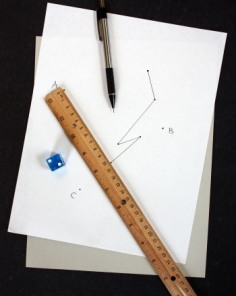I love innovative learning opportunities. A guest author sent me this fun STEM lesson plan that applies nicely to science, math, and computer science. Feel free to try it out and let me know what you think!
Type
Mathematics, Physics, Computer Science
Objective
This experiment will explore if a randomly iterated algorithm will result in a pattern.
Research Questions
- Can patterns be pulled out of a seemingly random algorithm?
- How long does an algorithm have to be repeated until a pattern appears?
Introduction
Iterated algorithms are very important for mathematics today. By repeating equations, scientists are finding brand new things out about the natural world (populations, epidemics, etc.). Iterated algorithms help us forecast the weather as well as predict how a faucet drips.
Materials
- Large piece of paper
- Pencil
- Ruler
- Die
- Camera
- Computer
 Experimental Procedure
Experimental Procedure
- Draw three points on the paper, making a loose triangle. Label these points A, B, and C.
- Draw another point anywhere on the paper. This is the “seed.”
- Roll the die.
- If a 1 or 2 comes up, use the ruler to draw a line halfway between the seed and point A. If a 3 or 4 comes up, draw a line halfway to point B. If a 5 or 6 comes up, draw the line halfway to point C.
- This point, halfway between the original seed and A, B, or C, is your new seed.
- Repeat Step 3 and 4 for the new seed.
- Keep on repeating as long as possible. Take photos along the way.
- You will reach a point where your materials will be too big and clumsy to continue. Stop.
- Analyze this data. Does a pattern emerge? What would it look like if you could iterate your algorithm many more times?
- If you have basic programming skills, attempt to create a computer program that could iterate this algorithm thousands of times. Does a pattern emerge now?
Concepts
Fractals, iterated algorithm, The Sierpinski Triangle
Many thanks to author, Barry Eitel! Find more fun and engaging learning activities for high school at Education.com!